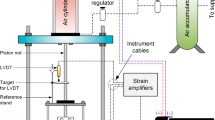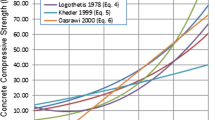Abstract
Theoretical and phenomenological models for predicting the compressive strength of concrete proposed in literature have been reviewed. The applicability and accuracy of these models in predicting the compressive strength of concrete at 28 days and at different ages were investigated using experimental data reported in the literature. Assessment of the models using visual display and numerical methods have revealed that the Average Paste Thickness (APT) compressive strength model, which accounts for the type of cement, cement degree of hydration, mixture proportions, aggregate proportions, gradations, packing density, and air content, provides the highest predictability at 28 days and at different ages. The assessment revealed that the majority of models give acceptable predictions because strength is mostly affected by water-to-cement ratio (w/c) in comparison to aggregates’ properties and gradation.
Similar content being viewed by others
References
Abrams, L. D. (1919). Properties of concrete, 3rd edition, Pitman Publishing LTD, London.
ASTM C192-02 (2002). Making and curing concrete specimens in the laboratory.
ASTM C39-05 (2005). Standard test method for compressive strength of cylindrical specimens.
Basheer, L., Basheer, P. A. M., and Long, A. E. (2005). “Influence of coarse aggregate on the permeation, durability and the microstructure characteristics of ordinary portland cement concrete.” Construction and Building Materials, Vol. 19, No. 9, pp. 682–690, DOI: 10.1016/j.conbuildmat.2005.02.022.
Bloem, D. L. and Walker, S. (1960). “Effects of aggregate size on properties of concrete.” ACI Materials Journal, Vol. 57, No. 13, pp. 283–297.
Chidiac, S. E., Moutassem, F., and Mahmoodzadeh, F. (2013). “Compressive strength model for concrete.” Journal of Magazine of Concrete Research, Vol. 65, No. 9, pp. 557–572, DOI: 10.1680/macr.12.00167.
de Larrard, F. (1999). Concrete mixture proportioning: A scientific approach, Spon Press, London.
de Larrard, F. and Belloc, A. (1997). “The influence of aggregate on the compressive strength of normal and high-strength concrete.” ACI Materials Journal, Vol. 94, No. 5, pp. 417–425.
Feret, R. (1892). “Sur la compacité des mortiers hydrauliques (On the compactness of hydraulic mortars).” Annales des Ponts et Chaussées, Vol. 7, No. 4, pp. 5–164.
Gallo, G. E. and Popovics, J. S. (2005). The use of surface waves to estimate in-place strength of concrete. Journal of Advanced Concrete Technology, Vol. 3, No. 3, pp. 355–362, DOI: 10.3151/jact.3.355.
Gardner, N. J. (1990). “Effect of temperature on the early-age properties of type I, type III, and type I/fly ash concrete.” ACI Materials Journal, Vol. 87, No. 1, pp. 68–78.
Hwang, S. D., Lee, K. M., Kim, J. K., and Kim, J. H. (2001). “Microstructure model for estimating early-age concrete strength.” First International Structural Engineering and Construction Conference, Honolulu, HI, pp. 493–498.
Karni, J. (1974). “Prediction of compressive strength of concrete.” Materials and Structures Journal, Vol. 7, No. 39, pp. 197–200, DOI: 10.1007/BF02473835.
Kim, J. K., Moon, J. H., and Eo, S. H. (1998). “Compressive strength development of concrete with different curing time and temperature.” Cement and Concrete Research, Vol. 28, No. 12, pp. 1761–1773, DOI: 10.1016/S0008-8846(98)00164-1.
Kolias, S. and Georgiou, C. (2005). “The effect of paste volume and of water content on the strength and water absorption of concrete.” Cement and Concrete Composites, Vol. 27, No. 2, pp. 211–216, DOI: 10.1016/j.cemconcomp.2004.02.009.
Kosmatka, S. H., Kerkhoff, B., and Panarese, W. C. (2002). Design and control of concrete mixtures, 7th Canadian Edition, Cement Association of Canada.
Mechling, J. M., Lecomte, A., and Diliberto, C. (2009). Relation between cement composition and compressive strength of pure pastes. Cement and Concrete Composites, Vol. 31, No. 4, pp. 255–262, DOI: 10.1016/j.cemconcomp.2009.02.009.
Mehta, P. K. and Monteiro, P. (2006). Concrete: microstructure, properties, and materials, 3rd edition, McGraw-Hill, USA.
Montgomery, D. C. and Runger, G. C. (2003). Applied statistics and probability for engineers, 3rd edition, New York: John Wiley and Sons Inc.
Namyong, J., Sangchun, Y., and Hongbum, C. (2004). “Prediction of compressive strength of in-situ concrete based on mixture proportion.” Journal of Asian Architecture and Building Engineering, Vol. 3, No. 1, pp. 9–16, DOI: 10.3130/jaabe.3.9.
Neville, A. M. (1981). Properties of concrete, 3rd edition, Pitman Publishing Ltd., London.
Nipatsat, N. and Tangtermsirikul, S. (2000). “Compressive strength prediction model for fly ash concrete.” Thammasat International Journal of Science and Technology, Vol. 5, No. 1, pp. 1–7.
Pann, K. S., Yen, T., Tang, C. W., and Lin, T. D. (2003). “New strength model based on water-cement ratio and capillary porosity.” ACI Materials Journal, Vol. 100, No. 4, pp. 311–318.
Popovics, S. (1985). “New formulas for the prediction of the effect of porosity on concrete strength.” ACI Materials Journal, Vol. 82. No. 2, pp. 136–146.
Popovics, S. (1998). “History of a mathematical model for strength development of portland cement concrete.” ACI Materials Journal, Vol. 95, No. 5, pp. 593–600.
Popovics, S. and Ujhelyi, J. (2008). “Contribution to the concrete strength versus water-cement ratio relationship.” Journal of Materials in Civil Engineering, Vol. 20, No. 7, pp. 459–463, DOI: 10.1061/(ASCE)0899-1561(2008)20:7(459).
Powers, T. C. and Brownyard, T. L. (1946). “Studies of the physical properties of hardened portland cement paste.” Proceedings of the American Concrete Institute, Vol. 18, No. 2, pp. 669–712.
Quiroga, P. (2003). The effect of the aggregate characteristics on the performance of portland cement concrete, PhD Dissertation, The University of Texas at Austin.
Rasmussen, R. O., Ruiz, J. M., Rozycki, D. K., and McCullough, B. F. (2002). “Constructing high-performance concrete pavements with FHWA HIPERPAV systems analysis software.” Transportation Research Board, Washington DC, pp. 11–20.
Schindler, A. K. and Folliard, K. J. (2005). “Heat of hydration models for cementitious materials.” ACI Materials Journal, Vol. 102, No. 1, pp. 24–33.
Tango, C. E. S. (2000). “Time-generalisation of Abrams' model for high performance concrete and practical application examples.” Proceedings of the International Symposium on High Performance Concrete, Hong Kong University of Science and Technology.
Wong, H. H. C. and Kwan, A. K. H. (2008). “Packing density of cementitious materials: Measurement and modelling.” Magazine of Concrete Research, Vol. 60, No. 3, pp. 165–175, DOI: 10.1680/macr.2007.00004.
Yeh, I. C. (2006). “Generalization of strength versus water-cementations ratio relationship to age.” Cement and Concrete Research, Vol. 36, No. 10, pp. 1865–1873, DOI: 10.1016/j.cemconres.2006.05.013.
Zain, M. F. M. and Abd, S. M. (2009). “Multiple regression model for compressive strength prediction of high performance concrete.” Journal of Applied Sciences, Vol. 9, No. 1, pp. 155–160, DOI: 10.3923/jas.2009.155.160.
Author information
Authors and Affiliations
Corresponding author
Rights and permissions
About this article
Cite this article
Moutassem, F., Chidiac, S.E. Assessment of concrete compressive strength prediction models. KSCE J Civ Eng 20, 343–358 (2016). https://doi.org/10.1007/s12205-015-0722-4
Received:
Revised:
Accepted:
Published:
Issue Date:
DOI: https://doi.org/10.1007/s12205-015-0722-4




